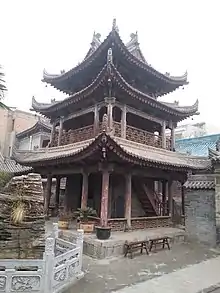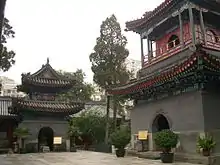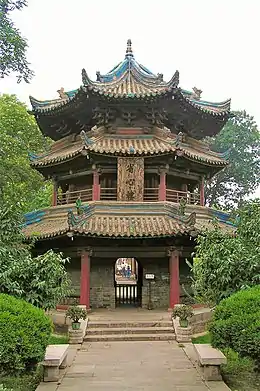Chinese Islamic architecture
Chinese Islamic architecture or the Islamic architecture of China is a term used to indicate the architectural heritage of the Muslims in China both of mainland or outer China since the earliest times to the present. With the acculturation of Islam within Han Chinese culture, a unique architecture emerged in accordance with Islamic teachings. It became standard to incorporate traditional Chinese and Islamic architectural elements together for mosques and other buildings.[1]
Islam has been practiced in Chinese society for 1,400 years.[4] Currently, Muslims are a minority group in China, representing between 0.45% to 1.8% of the total population according to the latest estimates.[5][6] Though Hui Muslims are the most numerous group,[7] the greatest concentration of Muslims is in Xinjiang, with a significant Uyghur population. Lesser but significant populations reside in the regions of Ningxia, Gansu and Qinghai.[8] Of China's 55 officially recognized minority peoples, ten groups are predominantly Sunni Muslim.[8]
| Part of a series on Islam in China |
|---|
.jpg.webp) |
|
|
Background
The Huaisheng Mosque's construction is attributed to the Prophet Muhammad's second cousin, Sa`d ibn Abi Waqqas.
According to Chinese Muslims' traditional legendary accounts, Islam was first introduced to China in 616–18 AD by Sahaba (companions) of Prophet Muhammad : Sa`d ibn Abi Waqqas, Sayid, Wahab ibn Abu Kabcha and another Sahaba.[9] Wahab ibn abu Kabcha (Wahb abi Kabcha) may have been be a son of al-Harth ibn Abdul Uzza (also known as Abu Kabsha).[10] It is noted in other accounts that Wahab Abu Kabcha reached Canton by sea in 629 CE.[11]
Sa`ad ibn Abi Waqqas, along with three Sahabas, namely Suhayla Abuarja, Uwais al-Qarani, and Hassan ibn Thabit, returned to China from Arabia in 637 by the Yunan-Manipur-Chittagong route, then reached Arabia by sea.[12] Some sources date the introduction of Islam in China to 650 AD, the third sojourn of Sa`d ibn Abi Waqqas,[13] when he was sent as an official envoy to Emperor Gaozong during Caliph Uthman's reign.[14]
The History of Islam in China goes back to the earliest years of Islam. According to China Muslims' traditional legendary accounts, eighteen years after Muhammad's death, the third Caliph of Islam, Uthman ibn Affan sent a delegation led by Sa`d ibn Abi Waqqas, the maternal uncle of Muhammad, to the Chinese Gaozong Emperor.
According to scholar Hamada Hagras, "Chinese historical sources indicate that the Chinese had not heard about Islam only in 639 A.D., according to the old Book of Tang Jiu Tangshu the Emperor Taizong (626‐649) received an embassy from the last Sassanid rulers Yazdegerd III asking for help against the invading Arab armies of his country. however, the emperor avoid to help him".[15][16]
According to Chinese Muslims' traditional legendary accounts, Islam was first brought to China by an embassy sent by Uthman, the third Caliph, in 651, less than twenty years after the death of prophet Muhammad. The embassy was led by Sa`d ibn Abī Waqqās, the maternal uncle of the prophet himself. Emperor Gaozong, the Tang emperor who received the envoy then ordered the construction of the Memorial mosque in Canton, the first mosque in the country, in memory of the prophet.[17]
While modern historians say that there is no evidence for Waqqās himself ever coming to China,[17] they do believe that Muslim diplomats and merchants arrived to Tang China within a few decades from the beginning of the Muslim Era.[17] The Tang dynasty's cosmopolitan culture, with its intensive contacts with Central Asia and its significant communities of (originally non-Muslim) Central and Western Asian merchants resident in Chinese cities, which helped the introduction of Islam.[17]
Hamada Hagras in which he reported that "Islam arrived China during Tang era in 651, during summer of the second year of the era of Emperor Gaozong; in that year was the first Arab embassy to the court of the Tang Dynasty, This is the first direct contact between the Chinese and the Arabs".[15][16] Arab people are first noted in Chinese written records, under the name Dashi in the annals of the Tang dynasty (618–907), (Tashi or Dashi is the Chinese rendering of Tazi—the name the Persian people used for the Arabs).[18] Records dating from 713 speak of the arrival of a Dashi ambassador. The first major Muslim settlements in China consisted of Arab and Persian merchants.[19]
Arab sources claim Qutayba ibn Muslim briefly took Kashgar from China and withdrew after an agreement[20] but modern historians entirely dismiss this claim.[21][22][23]
The Arab Umayyad Caliphate in 715 AD deposed Ikhshid, the king the Fergana Valley, and installed a new king Alutar on the throne. The deposed king fled to Kucha (seat of Anxi Protectorate), and sought Chinese intervention. The Chinese sent 10,000 troops under Zhang Xiaosong to Ferghana. He defeated Alutar and the Arab occupation force at Namangan and reinstalled Ikhshid on the throne.[24]
Tang period


the earliest Chinese Islamic architecture was the Great Mosque in Xian was built in 742 (according to an engraving on a stone tablet inside), and the Daxuexi Alley Mosque in Xi'an (According to the inscription of the emperor Jiajing of Ming Dynasty; the mosque was built in 705)[16][26]

Song-Liao Period
There are many examples of Islamic architecture during Song and Liao Dynasties; the Niujie Mosque in Beijing (simplified Chinese: 牛街礼拜寺; traditional Chinese: 牛街禮拜寺; pinyin: Niújiē lǐbàisì; Wade–Giles: Niu-chieh Li-pai-ssu "Oxen Street House of Worship" or Chinese: 牛街清真寺; pinyin: 'Niújiē Qīngzhēnsì'; Wade–Giles: Niu-chieh Ch'ing-chen-ssu "Oxen Street Mosque") is the oldest mosque in Beijing, China. It was first built in 996 during the Liao Dynasty and was reconstructed as well as enlarged under the Cheng Hua Emperor of the Ming dynasty who granted the mosque financial support in 1474,[26] and the Kangxi Emperor (r. 1661–1722) of the Qing Dynasty.[27] and the Huaisheng Mosque in Guangzhou.[28]
Yuan period
During the Yuan dynasty, Chinese Muslims began referring to their mosques as qingzhensi (temple of purity and truth).[29]
There are many examples of Islamic architecture during Yuan such as Beijing Dongsi Mosque (北京东四清真寺) which enlarged during Ming dynast,[26] Beijing Tongzhou Mosque (北京通州清真寺), Quanzhou Qingjing Mosque (泉州清净寺) which has the only example of stone entrances, Hangzhou Fenghuang Mosque (杭州风凰寺).[16] This period was characterized by Islamic architectural elements such as high entrances, domes, transition zones, use of bricks and stones.[30][16]
Ming period
During the Ming dynasty, construction of lecture halls within mosques began in Shaanxi and later spread throughout China.[1]
References
- Yanxin, Cai (2011). Chinese Architecture. Cambridge University Press. pp. 94–96. ISBN 978-0-521-18644-5.
- For China Family Panel Studies 2017 survey results see release #1 (archived) and release #2 (archived). The tables also contain the results of CFPS 2012 (sample 20,035) and Chinese General Social Survey (CGSS) results for 2006, 2008 and 2010 (samples ≈10.000/11,000). Also see, for comparison CFPS 2012 data in Lu 卢, Yunfeng 云峰 (2014). "卢云峰:当代中国宗教状况报告——基于CFPS(2012)调查数据" [Report on Religions in Contemporary China – Based on CFPS (2012) Survey Data] (PDF). World Religious Cultures (1). Archived from the original (PDF) on 9 August 2014. p. 13, reporting the results of the CGSS 2006, 2008, 2010 and 2011, and their average (fifth column of the first table).
- Data from: Yang Zongde, Study on Current Muslim Population in China, Jinan Muslim, 2, 2010.
- Gladney, Dru C. (2003). "The China Quarterly - Islam in China: Accommodation or Separatism? - Cambridge Journals Online". The China Quarterly. 174: 451–467. doi:10.1017/S0009443903000275. S2CID 154306318.
- For China Family Panel Studies 2017 survey results see release #1 (archived) and release #2(). The tables also contain the results of CFPS 2012 (sample 20,035) and Chinese General Social Survey (CGSS) results for 2006, 2008 and 2010 (samples ≈10.000/11,000). Also see, for comparison CFPS 2012 data in Lu 卢, Yunfeng 云峰 (2014). "卢云峰:当代中国宗教状况报告——基于CFPS(2012)调查数据" [Report on Religions in Contemporary China – Based on CFPS (2012) Survey Data] (PDF). World Religious Cultures (1). Archived from the original (PDF) on 9 August 2014. Retrieved 10 July 2019. p. 13, reporting the results of the CGSS 2006, 2008, 2010 and 2011, and their average (fifth column of the first table).
- "The World Factbook". cia.gov. Retrieved 2007-05-30.
- "China halts mosque demolition due to protest". Archived from the original on 2018-08-11. Retrieved 2018-08-10.
- Armijo 2006
- Dru C. Gladney, Muslim Tombs & Ethnic Folklore-Hui Identity, in The Journal of Asian Studies, California, vol.16, No.3, Aug. 1987, p. 498, p. 498 nt.8.
- Safi-ur Rahman Al-Mubarakpuri, 2009, Ar-Raheeq al-Makhtum: The Sealed Nectar: Biography of the Noble Prophet, Madinah: Islamic University of Al-Madinah al-Munawwarah, page 72: The Prophet was entrusted to Halimah...Her husband was Al-Harith bin Abdul Uzza called Abi Kabshah, from the same tribe
- Claude Philibert Dabry de Thiersant (1878). Le mahométisme en Chine et dans le Turkestan oriental (in French). Leroux.
- Maazars in China-www.aulia-e-hind.com/dargah/Intl/Chin
- BBC 2002, Origins
- Abul-Fazl Ezzati, 1994, The Spread of Islam, Tehran: Ahlul Bayt World Assembly Publications, pp. 300,303, 333.
- Hagras, Hamada (2017). "An Ancient Mosque in Ningbo, China "Historical and Architectural Study"". Journal of Islamic Architecture. 4 (3): 102–113. doi:10.18860/jia.v4i3.3851.
- Hamada, Hagras (2019). "XI'AN DAXUEXI ALLEY MOSQUE: HISTORICAL AND ARCHITECTURAL STUDY". Egyptian Journal of Archaeological and Restoration Studies "EJARS". 1: 97–113. Archived from the original on 2019-12-13. Retrieved 2019-07-10.
- Lipman 1997, p. 25
- Israeli, Raphael (2002). Islam in China. United States of America: Lexington Books. ISBN 0-7391-0375-X.
- Israeli (2002), pg. 291
- Muhamad S. Olimat (27 August 2015). China and Central Asia in the Post-Soviet Era: A Bilateral Approach. Lexington Books. pp. 10–. ISBN 978-1-4985-1805-5.
- Litvinsky, B. A.; Jalilov, A. H.; Kolesnikov, A. I. (1996). "The Arab Conquest". In Litvinsky, B. A. (ed.). History of civilizations of Central Asia, Volume III: The crossroads of civilizations: A.D. 250 to 750. Paris: UNESCO Publishing. pp. 449–472. ISBN 978-92-3-103211-0.
- Bosworth, C. E. (1986). "Ḳutayba b. Muslim". In Bosworth, C. E.; van Donzel, E.; Lewis, B. & Pellat, Ch. (eds.). The Encyclopaedia of Islam, New Edition, Volume V: Khe–Mahi. Leiden: E. J. Brill. pp. 541–542. ISBN 978-90-04-07819-2.
- Gibb, H. A. R. (1923). The Arab Conquests in Central Asia. London: The Royal Asiatic Society. pp. 48–51. OCLC 685253133.
-
- Bai, Shouyi et al. (2003). A History of Chinese Muslim (Vol.2). Beijing: Zhonghua Book Company. ISBN 7-101-02890-X., pp. 235-236
- Hagras, Hamada (2019). "Xi'an Daxuexi Alley Mosque: Historical and Architectural Study". Egyptian Journal of Archaeological and Restoration Studies "EJARS". 1: 97–113. Archived from the original on 2019-12-13. Retrieved 2019-07-10.
- Hagras, Hamada (2019-12-20). "The Ming Court as Patron of the Chinese Islamic Architecture: The Case Study of the Daxuexi Mosque in Xi'an". SHEDET (6): 134–158. doi:10.36816/shedet.006.08.
- "Restorations: Olympic Torch Or Rural Touch?". China Heritage Quarterly. Retrieved 28 October 2012.
- Hagars, Hamada (2019). "Xi'an Daxuexi Alley Mosque: Historical and Architectural Study". Egyptian Journal of Archaeological and Restoration Studies "EJARS". 1: 97–113. Archived from the original on 2019-12-13. Retrieved 2019-07-10.
- Maria, Jaschok; Jingjun, Shui (2005). "Islamic Mosques". Encyclopedia of Contemporary Chinese Culture. Taylor & Francis. p. 288. ISBN 978-0-415-77716-2.
- Hagras, Hamada Muhammed (2017-06-20). "An Ancient Mosque In Ningbo, China "Historical And Architectural Study"". Journal of Islamic Architecture. 4 (3): 102. doi:10.18860/jia.v4i3.3851. ISSN 2356-4644.
.png.webp)
